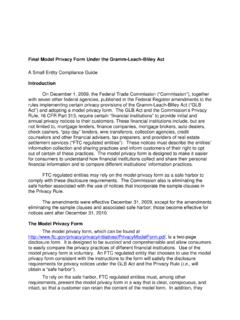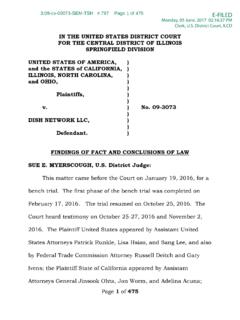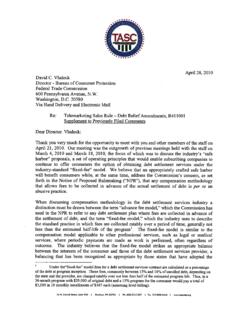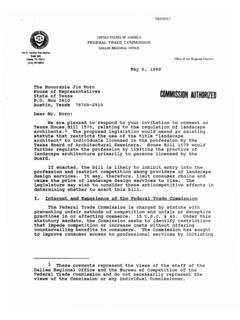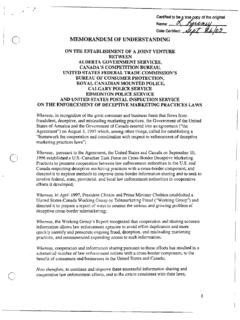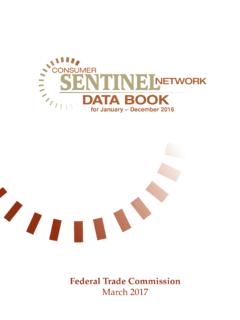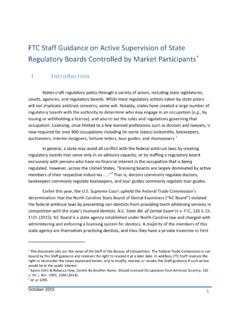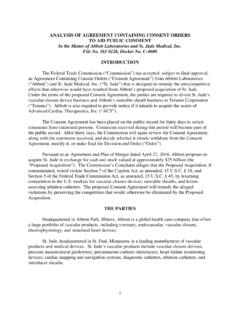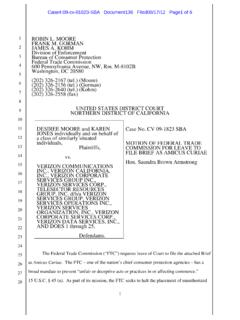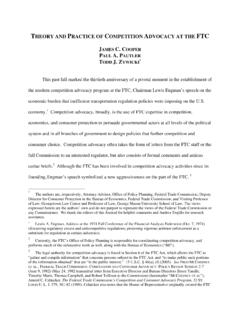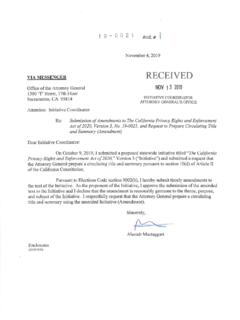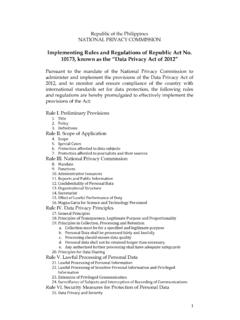Transcription of Internet of Things: Privacy & Security in a Connected World
1 Privacy & Security in a Connected WorldFTC Sta ReportJANUARY 2015 FTC Staff Report January 2015 Table of Contents Executive Summary .. i Background .. 1 What is the Internet of things ?.. 5 Benefits & Risks .. 7 Benefits .. 7 Risks .. 10 Application of Traditional Privacy Principles .. 19 Summary of Workshop Discussions .. 19 Post-Workshop Developments .. 25 Commission Staff s Views and Recommendations for Best Practices .. 27 Legislation .. 47 Summary of Workshop Discussions .. 47 Recommendations .. 48 Conclusion .. 55 i Executive Summary The Internet of things ( IoT ) refers to the ability of everyday objects to connect to the Internet and to send and receive data. It includes, for example, Internet - Connected cameras that allow you to post pictures online with a single click; home automation systems that turn on your front porch light when you leave work; and bracelets that share with your friends how far you have biked or run during the day.
2 Six years ago, for the first time, the number of things Connected to the Internet surpassed the number of people. Yet we are still at the beginning of this technology trend. Experts estimate that, as of this year, there will be 25 billion Connected devices, and by 2020, 50 billion. Given these developments, the FTC hosted a workshop on November 19, 2013 titled The Internet of things : Privacy and Security in a Connected World . This report summarizes the workshop and provides staff s recommendations in this C onsistent with the FTC s mission to protect consumers in the commercial sphere and the focus of the workshop, our discussion is limited to IoT devices that are sold to or used by consumers. Accordingly, the report does not discuss devices sold in a business-to-business context, nor does it address broader machine-to-machine communications that enable businesses to track inventory, functionality, or efficiency.
3 Workshop participants discussed benefits and risks associated with the IoT. As to benefits, they provided numerous examples, many of which are already in use. In the health arena, Connected medical devices can allow consumers with serious medical conditions to work 1 Commissioner Wright dissents from the issuance of this Staff Report. His concerns are explained in his separate dissenting statement. ii with their physicians to manage their diseases. In the home, smart meters can enable energy providers to analyze consumer energy use, identify issues with home appliances, and enable consumers to be more energy-conscious. On the road, sensors on a car can notify drivers of dangerous road conditions, and software updates can occur wirelessly, obviating the need for consumers to visit the dealership. Participants generally agreed that the IoT will offer numerous other, and potentially revolutionary, benefits to consumers.
4 As to risks, participants noted that the IoT presents a variety of potential Security risks that could be exploited to harm consumers by: (1) enabling unauthorized access and misuse of personal information; (2) facilitating attacks on other systems; and (3) creating risks to personal safety. Participants also noted that Privacy risks may flow from the collection of personal information, habits, locations, and physical conditions over time. In particular, some panelists noted that companies might use this data to make credit, insurance, and employment decisions. Others noted that perceived risks to Privacy and Security , even if not realized, could undermine the consumer confidence necessary for the technologies to meet their full potential, and may result in less widespread adoption. In addition, workshop participants debated how the long-standing Fair Information Practice Principles ( FIPPs ), which include such principles as notice, choice, access, accuracy, data minimization, Security , and accountability, should apply to the IoT space.
5 The main discussions at the workshop focused on four FIPPs in particular: Security , data minimization, notice, and choice. Participants also discussed how use-based approaches could help protect consumer Privacy . iii 1. Security There appeared to be widespread agreement that companies developing IoT products should implement reasonable Security . Of course, what constitutes reasonable Security for a given device will depend on a number of factors, including the amount and sensitivity of data collected and the costs of remedying the Security vulnerabilities. Commission staff encourages companies to consider adopting the best practices highlighted by workshop participants, including those described below. First, companies should build Security into their devices at the outset, rather than as an afterthought. As part of the Security by design process, companies should consider: (1) conducting a Privacy or Security risk assessment; (2) minimizing the data they collect and retain; and (3) testing their Security measures before launching their products.
6 Second, with respect to personnel practices, companies should train all employees about good Security , and ensure that Security issues are addressed at the appropriate level of responsibility within the organization. Third, companies should retain service providers that are capable of maintaining reasonable Security and provide reasonable oversight for these service providers. Fourth, when companies identify significant risks within their systems, they should implement a defense-in-depth approach, in which they consider implementing Security measures at several levels. Fifth, companies should consider implementing reasonable access control measures to limit the ability of an unauthorized person to access a consumer s device, data, or even the consumer s network. Finally, companies should continue to monitor products throughout the life cycle and, to the extent feasible, patch known vulnerabilities.
7 Iv 2. Data Minimization Data minimization refers to the concept that companies should limit the data they collect and retain, and dispose of it once they no longer need it. Although some participants expressed concern that requiring data minimization could curtail innovative uses of data, staff agrees with the participants who stated that companies should consider reasonably limiting their collection and retention of consumer data. Data minimization can help guard against two Privacy -related risks. First, larger data stores present a more attractive target for data thieves, both outside and inside a company and increases the potential harm to consumers from such an event. Second, if a company collects and retains large amounts of data, there is an increased risk that the data will be used in a way that departs from consumers reasonable expectations. To minimize these risks, companies should examine their data practices and business needs and develop policies and practices that impose reasonable limits on the collection and retention of consumer data.
8 However, recognizing the need to balance future, beneficial uses of data with Privacy protection, staff s recommendation on data minimization is a flexible one that gives companies many options. They can decide not to collect data at all; collect only the fields of data necessary to the product or service being offered; collect data that is less sensitive ; or de-identify the data they collect. If a company determines that none of these options will fulfill its business goals, it can seek consumers consent for collecting additional, unexpected categories of data, as explained below. v 3. Notice and Choice The Commission staff believes that consumer choice continues to play an important role in the IoT. Some participants suggested that offering notice and choice is challenging in the IoT because of the ubiquity of data collection and the practical obstacles to providing information without a user interface.
9 However, staff believes that providing notice and choice remains important. This does not mean that every data collection requires choice. The Commission has recognized that providing choices for every instance of data collection is not necessary to protect Privacy . In its 2012 Privacy Report, which set forth recommended best practices, the Commission stated that companies should not be compelled to provide choice before collecting and using consumer data for practices that are consistent with the context of a transaction or the company s relationship with the consumer. Indeed, because these data uses are generally consistent with consumers reasonable expectations, the cost to consumers and businesses of providing notice and choice likely outweighs the benefits. This principle applies equally to the Internet of things . Staff acknowledges the practical difficulty of providing choice when there is no consumer interface and recognizes that there is no one-size-fits-all approach.
10 Some options include developing video tutorials, affixing QR codes on devices, and providing choices at point of sale, within set-up wizards, or in a Privacy dashboard. Whatever approach a company decides to take, the Privacy choices it offers should be clear and prominent, and not buried within lengthy documents. In addition, companies may want to consider using a combination of approaches. Some participants expressed concern that even if companies provide consumers with choices only in those instances where the collection or use is inconsistent with context, such an vi approach could restrict unexpected new uses of data with potential societal benefits. These participants urged that use limitations be considered as a supplement to, or in lieu of, notice and choice. With a use-based approach, legislators, regulators, self-regulatory bodies, or individual companies would set permissible and impermissible uses of certain consumer data.
